Managing El Niño Storm Runoff
by Julie P. Newman, Don Merhaut, Darren Haver, John N. Kabashima and Ben Faber
California nursery growers need to prepare for El Niño storms that could potentially produce heavy runoff flows, flooding and mudslides. Each nursery should have a plan on how this excess runoff will be mitigated. This is important not only to prevent property loss, but also to limit the movement of sediment, pesticides, fertilizers and other contaminants into surface and ground waters. A summary of common mitigation methods are provided in this article.
Reduce Pesticide and Fertilizer Loads
Limit the amount of pesticides and fertilizers carried in stormwater runoff by implementing BMPs that reduce the use of these agrichemicals; handle and store pesticides and fertilizers in a manner that minimizes their loss to the environment. Newman and others (2008) provide a list of these BMPs that can be used in developing a nursery water quality management plan. Practices to reduce fertilizer and pesticide loads are described in detail in the Container Nursery Production and Business Manual (Evans 2014, Newman and others 2014).
Limit Movement of Soil Particles
Sediment (loose particles of clay, silt and sand) is the most common nonpoint source pollutant, and in excessive amounts has serious implications for the health of the aquatic environment. Moreover, many pesticides, fertilizers and other constituents of concern in runoff are adsorbed to soil particles. It is important to determine the location, amount and causes of stormwater runoff in outdoor nursery production areas and nonproduction areas (e.g., roads, hillsides). Practices to reduce soil erosion at its source and methods for trapping sediment on-site must be included in nursery water quality management plans and implemented (Haver 2004).
Media. Potting mix is a primary source of pesticides and nutrients found in nursery runoff so it is important to clean up spills. See Don Merhaut’s “Get Cultured” in this issue for more information on media storage.
Roads. Nursery roads must be properly designed and constructed to prevent excess runoff and erosion during storm events that can pollute water supplies, increase flooding potential and trigger landslides (fig. 1–4A). Adequate road drainage from both the road surface and hill slope is important. Detailed information on the design of roads, appropriate drainage structures and regulation requirements can be found in several publications listed in the references (Bender 2014, Newman and others 2014, Newman 2012).
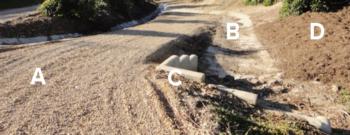
Regrade roads to maintain proper road dimensions and slope, remove deep ruts, and repair damaged areas caused by storms only during dry weather. Avoid excessive road maintenance. Using roads during wet weather may aggravate erosion and drainage problems, particularly when roads are not protected by vegetation or gravel (fig. 1–2).
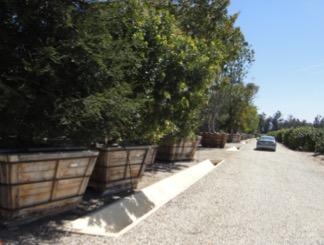
Sediment barriers. The use of sandbags, erosion control blankets, jute mesh, wattles and gravel provide a significant degree of erosion control over the absence of any mitigation method. Some sediment barriers (e.g., erosion control blankets and jute mesh (fig. 4B), made from natural or synthetic polymer fibers), can provide ground and slope stabilization, facilitating vegetation establishment. Jute materials last longer than sandbags or straw bales; they are available in assorted sizes and configurations to match all situations.
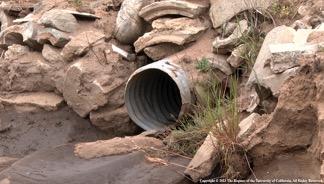
Sediment pits and sediment basins. Sediment pits or traps (fig. 5) slow the movement of surface runoff and allow for the settling of large, heavy particles such as sand used in container mixes. For intercepting larger amounts of sediment, a sediment basin (fig. 6) can be constructed at the base of a nursery field. Sediment pits and basins should be designed for easy clean out, which should be done prior to winter storms. Lining with an impervious material will facilitate easier removal of collected sediment and avoid seepage into groundwater. Information on design can often be obtained from public agencies or companies specializing in water treatment, in addition to the NRCS.
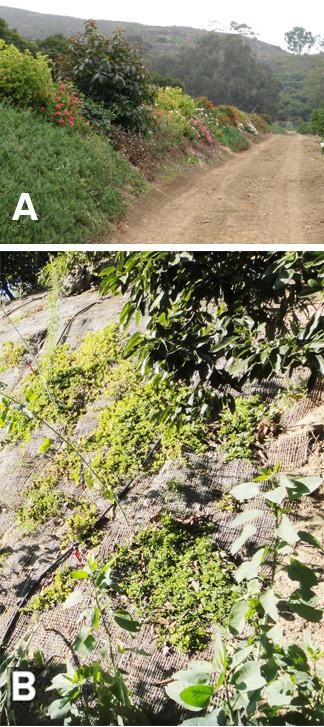
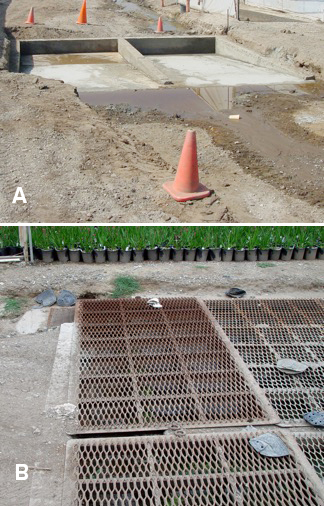
Ground covers. Bare soil areas in the nursery must be protected from concentrated flows of water by covering with ground covers. Ground covers prevent the soil surface from exposure to rain or irrigation drop impact, improving infiltration. Examples of ground covers include rock, gravel (fig. 1–2), mulch (fig. 1) and plant covers. Plant covers reduce the amount and speed of runoff and can trap sediment, thereby reducing soil losses considerably compared with bare soil. Plant covers include cover crops, landscaped areas, critical planting areas (fig. 4A) and vegetated buffers (fig. 7).
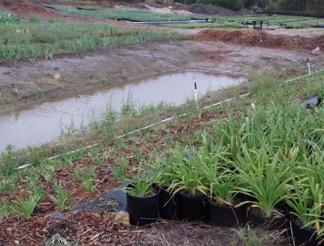
Newman and others (2014) describe types of vegetated buffers and the selection of plant materials. Planting should be timed so buffers are established prior to expected storm runoff. Buffers should be inspected regularly, especially after storm events, and damaged areas immediately repaired to sustain buffer function and effectiveness. Trapped sediment changes the shape of buffers, and it may cause runoff to flow parallel to buffers rather than across them. Therefore, periodically remove sediment and reshape the buffers. Dredge ditches lined with plants before seasonal storms.
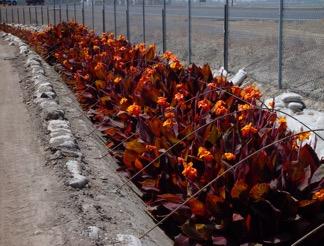
Terracing. Terracing is an effective treatment to control erosion on steep slopes (fig. 8). Some terraces are designed to collect water and temporarily store it until it can filter into the ground or be released through a stable outlet. Other terraces are designed as a channel to slow runoff and carry it to a stable outlet such as a grass waterway.
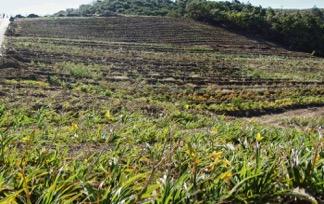
Control Stormwater Movement
Drainage structures and drainage systems. Drainage ditches and canals should be designed to handle peak runoff flows during storms. Underdesign can lead to choke points or overflow leaving the nursery. Roadside ditches, irrigation channels (fig. 2) and drainage structures such as culverts (fig. 3), inlets (see fig. 9) and underground outlets (conduits installed beneath the surface of the ground to collect surface water and convey it to a suitable outlet) should be inspected before and after each major runoff event; debris should be removed to restore flow capacity as needed. Clear debris and prune overgrown shrubs and brushes in natural drainage ditches that carry excess rainfall.
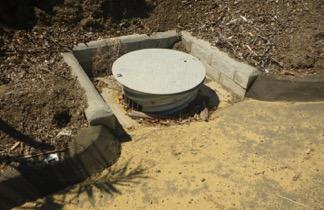
Control water movement in soil and container media. Practices that improve water-holding capacity and the infiltration of water into soil or container media include the use of mulches (fig. 1) and plant covers on bare soil areas in the nursery as well as the incorporation of amendments. Amendments improve soil structure so that the soil can absorb and hold more moisture, thus reducing runoff and related damage. Wetting agents may increase the water absorption of some soil textures, allowing faster wetting and reduced channeling down sides of pots. Wetting agents can also be used in field soils to improve infiltration rates where water repellency is a problem.
Conversely, in areas where groundwater contamination is a concern, percolation into the soil profile can be minimized by grading the soil (minimum 1.5% slope) so that water will flow to drainage ditches. Percolation can also be minimized by lining drainage ditches with a water-impermeable material, such as cement, plastic, or gunnite, or by installing drainage tile.
Greenhouse roof runoff. Roof runoff may contain pollutants such as toxic sediments and shading compounds. Direct greenhouse roof runoff to avoid flow across areas where contaminants will be washed into the municipal storm water, sewer system, or agricultural drainage system (fig. 10).
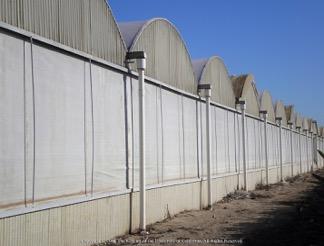
Capture Water and Sediment
Retention basins (fig. 11), ponds and other types of impoundments can be constructed to collect large runoff flow and retain (store) runoff water. Water dissipates by infiltrating into the ground (in unlined basins) and by evaporation. Overflow may be prevented by using the collected water in recycling systems or in the irrigation of landscapes and other noncrop areas. Sediment from the collected water can be removed by settling using sediment traps (fig. 5) or sediment basins (fig. 6). Flocculants can also be used to remove sediments (fig. 12). It’s important that impoundments are periodically dredged. Filtering systems should be cleaned of debris and sediment. Pumps used in recycling systems must be maintained in good working order in preparation for the rainy season. For more information on impoundments, refer to the Container Nursery Practices and Business Management Manual (Newman and others 2014).
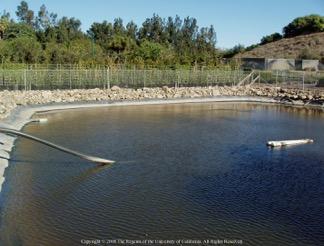
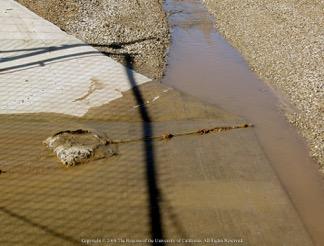
References
Bender GS. 2014. Establishing the citrus orchard, Chapter 2. In Ferguson L, Grafton-Cardwell EE (Ed) Citrus Production Manual. Univ. of Calif. Agric. and Nat. Resour. Publication 3539. Oakland, CA.
Evans RY. 2014. Nutrition and fertilization, Chapter 6. In Newman, J (Ed) Container Nursery Production and Business Management. Univ. of Calif. Agric. and Nat. Resour. Publication 3540. Oakland, CA.
Haver D. 2004. Sediment Management Goals and Management Practices for Nursery and Floriculture. Univ. of Calif. Agric. and Nat. Resour. Publication 8124. Oakland, CA.
http://anrcatalog.ucanr.edu/Details.aspx?itemNo=8124.
Merhaut DL, Corkidi L, Khuong T, Newman J, Mochizuki M, Daugovish O, Faber B, Melvin M. 2012. Implementation of Best Management Practices to reduce agricultural TMDL loads in the Calleguas Creek and Santa Clara River watersheds. Final Report. Los Angeles Regional Water Quality Control Board. Los Angeles Regional Water Quality Control Board. 424 p.
Newman JP, Kabashima JN, Merhaut D, Haver D, Gan J, Oki LR. 2014. Controlling nursery runoff and recycling water, nutrients, and waste, Chapter 8. In Newman J (Ed) Container Nursery Production and Business Management. Univ. of Calif. Agric. and Nat. Resour. Publication 3540. Oakland, CA.
Newman JP, Haver D, Mellano V, Robb K. 2008. Management goals and management practices to mitigate runoff and leaching, Chapter 2. In Newman J. (Ed) Greenhouse and Nursery Management Practices to Protect Water Quality. Univ. of Calif. Agric. and Nat. Resour. Publication 3508. Oakland, CA.
Newman J. 2012. Prevent runoff and erosion from greenhouse access roads. Greenhouse Management 32(12):15. http://www.greenhousemag.com/article/gm1212-greenhouse-access-roads.












